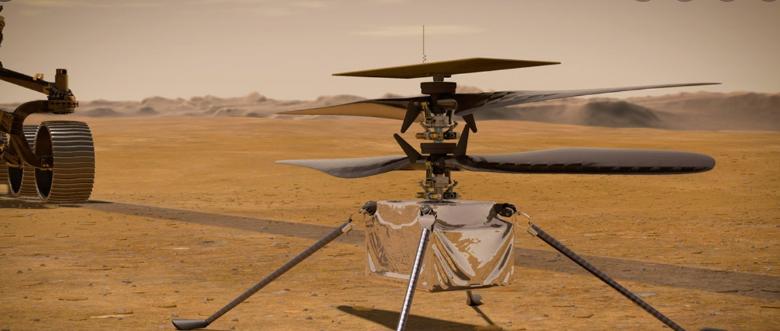You have to learn how to stand before you fly.
NASA's Witty Mars helicopter, which has been in the Perseverance rover on Mars for more than a month, is now gradually stretching out to gain a foothold on the Red Planet's iron-rich soil layer with four calves.
NASA released a short video of the Perseverance rover lowering the Witty helicopter to a position where it could land safely.

The reason why NASA launched a helicopter to Mars
On Feb. 18, the Perseverance Mars rover landed on Mars with a mission to explore ancient microbes that had survived. It's not just the one who goes on an expedition, there's a helicopter that follows it.
Witty was the first attempt by humans to make a controlled flight on another planet (the Soviet Union placed two balloons on Mercury in the 1980s). The helicopter is only 19 inches tall and two sets of four-legged carbon-based fiber rotors are moving in different directions.
"It's something that has never been tried in human history, and we're here to be the first to eat crabs." Former NASA administrator Jim Bridenstine told reporters in June.
Witty's petite size allowed it to be carried to Mars by Perseverance until now.
However, once Witty is ready to fly, Perseverance can only let go of its friends.
In the short video filmed by Perseverance, the Witty helicopter is gradually opening and stretching its four legs from where it is currently loaded, like a wildebeest cub that has just emerged from its mother's womb.
The helicopter stretched out four calves and prepared to land on Mars Image source: NASA/JPL
How does the Mars Helicopter work?
With the release of the second photo, we can see that all four legs of the helicopter have been extended and are about to land on the rugged surface of Mars. This whole process takes a full week.
Once Witty can stand on its own, Perseverance will carefully deploy its helicopters in the center of a selected 33-foot-long square airfield. Perseverance then leaves, leaving Wit alone to complete the task and start charging the solar cell.
When the helicopter is charged with solar panels, it can contact the research team through the Mars helicopter base station on the rover and then carry out matters related to testing its performance.
When will it be the first flight of a Mars helicopter?
Witty's first flight test is tentatively scheduled for April 8.
As part of its initial flight, Witty will fly a few feet off the ground and hover in the air for 20 to 30 seconds. Although brief, this first few tens of seconds of flight will become an important milestone in the history of space exploration.
The next flights will cover more distant and higher routes. Witty can fly for 90 seconds, with a maximum range of 980 feet and a maximum of 10 to 15 feet above the ground.
Tests for the helicopter will last 30 Martian days (similar to a day on Earth, but 40 minutes longer than a day).
How long will NASA's Witty helicopter stay on Mars?
Witty was not built with the standard of being able to survive in the harsh Martian atmosphere for a long time.
But several of its calves can successfully get out of Jezero Crater and will also pioneer the exploration of hovering over other planets with a flying machine.
For example, NASA is now embarking on a mission to send drones to Titan, a planet-sized moon of Saturn and the only natural satellite with a solid atmosphere. Titan is an important breakthrough in our search for life in the Sun.
Related knowledge
The Ingenuity(ingenuity), also known as the Little Wit,[3][4] was a Mars unmanned helicopter,[5][6] the first aircraft to "perform a power-controlled flight on another planet". Used in the Mars 2020 mission for demonstration of flight technology, it can provide a unique perspective that currently orbiting satellites or ground rovers and landers cannot provide. Provide high-definition images and reconnaissance for probes or humans, and enable rovers to access hard-to-reach terrain.
Witty separated from perseverance about 60 days after landing and deployed on April 3, 2021. [9] [1] Separation from Perseverance will be subject to a 30-day flight test at altitudes of 3 to 5 meters above ground and a distance of up to 300 meters (980 feet), with each flight lasting no more than three minutes and up to five flights. [10] Witty can take autonomous control in flight, communicating directly with Perseverance after each landing. [11] Witty's first test flight is scheduled for April 19, 2021 at 3:15 a.m. EDT (7:15 UTC), and the live webcast will take place three hours later at 6:15 a.m. (10:15 UTC). [12] [13] [14] Witty's first flight was successful, the first time a human has achieved controlled flight on another planet.
Witty will conduct four subsequent test missions over a 30-day Martian -- (about 31 Earth-days) window. The mission team will use the original ship to validate the technology needed to fly in the Martian atmosphere, laying the foundation for the preparation of advanced vehicles to be carried by robots or humans when exploring Mars in the future. These helicopters will be able to play a supporting role in future exploration missions, for example: as robot scouts, surveying terrain from above or as stand-alone science vehicles to carry instruments.
BY: inverse
FY: Dawn
If there is any infringement of the relevant content, please contact the author to delete it after the work is published
Please also obtain authorization to reprint, and pay attention to maintaining completeness and indicating source